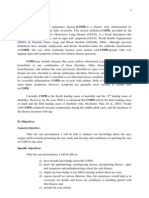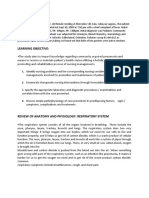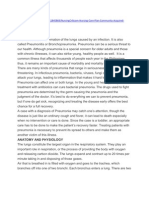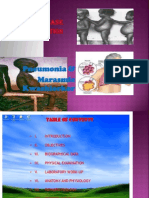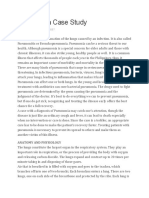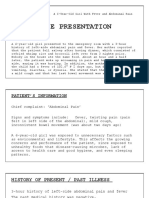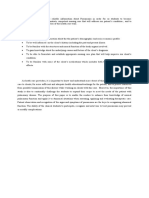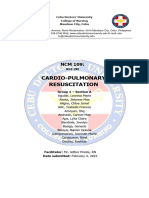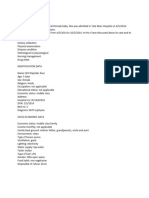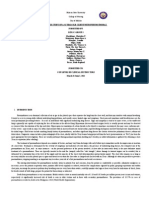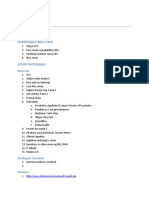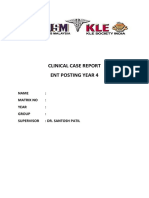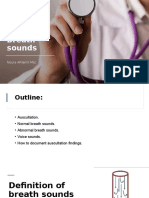Dear
Dear
Uploaded by
Louresa Mae TCopyright:
Available Formats
Dear
Dear
Uploaded by
Louresa Mae TCopyright
Available Formats
Share this document
Did you find this document useful?
Is this content inappropriate?
Copyright:
Available Formats
Dear
Dear
Uploaded by
Louresa Mae TCopyright:
Available Formats
CapitoI University
CoIIege of Nursing
CorraIes Extension, Cagayan de Oro City
PNEUMONIA
with PLEURAL EFFUSION
In partiaI fuIfiIIment of the Subject
ReIated Learning Experience RLE 30-GROUP 6
Submitted to:
Ms. Fredelina Santiago, R.N, M.N.
Clinical nstructor
Ms. Emy Barquez
PC
Submitted By:
#ubio, Mikhail
Sabado, Angie Low
San Gabriel, James
Suing, Lovely
Tonding, #azel Jean
Trazo, Nikki Jane
Tumanday, Louresa Mae
Vallecera, Mervin
Yasay, Kwesi Gem
Ybanez, ona Marie
ACKNOWLEDGEMENT
The group 6 wishes to thank several people. We would like to thank our clinical
nstructor Ms. Fredelina T. Saniago, for teaching us a lot of things that helped us during
the duty. The next person that we would like to thank for is our practicing clinical
instructor Ms. Emy Barquez, for guiding us in doing our duty as a student nurse. We
would also like to thank the staffs in the pedia ward, for cooperating with us even though
sometimes we are so annoying in getting the charts. And also, the parents of our
patient, for cooperating with us, and for understanding in our capacity in giving care to
their child. And the most important above all, GOD, thank you for the blessings and
guidance for making a successful duty every week. We hope that you will still guide us
in our future tasks that we're going to encounter. Thank you and GOD BLESS us all.
TABLE OF CONTENTS
I. Introduction 1
II. CIient's ProfiIe 2-3
III. Anatomy and PhysioIogy 4-6
IV. PathophysioIogy of Pneumonia 7-9
V. Diagnostic Procedures & Laboratory ResuIts 10-12
VI. Nursing Care PIan 13-22
VII. Drug Study 23-34
VIII. Discharge PIan 35-37
IX. Learning Experience 38
X. Reference 39
INTRODUCTION
A. OVERVIEW OF THE CASE
Pneumonia is an inflammation of the lungs caused by an infection. t is also
called Pneumonitis or Bronchopneumonia. Pneumonia can be a serious threat to our
health. Although pneumonia is a special concern for older adults and those with chronic
illnesses, it can also strike young, healthy people as well. t is a common illness that
affects thousands of people each year in the Philippines, thus, it remains an important
cause of morbidity and mortality in the country (http://nursingcrib.com/case-
study/pneumonia-case-study/)
Pneumonia can be classified in several ways. t is most commonly classified by
where or how it was acquired (community-acquired,aspiration, healthcare-
associated, hospital-acquired, and ventilator-associated pneumonia), but may also be
classified by the area of lung affected (lobar pneumonia, bronchial
pneumonia and acute interstitial pneumonia) or by the causative organism. Pneumonia
in children may additionally be classified based on signs and symptoms into non severe,
severe, and very severe. (http://en.wikipedia.org/wiki/Pneumonia)
A case with a diagnosis of Pneumonia may catch one's attention, though the
disease is just like an ordinary cough and fever, it can lead to death especially when no
intervention or care is done.
This study is intended for us to know better in the case where we always
encountered in every duty. n order to improve our skills and techniques in handling
those patients having severe pneumonia and also we want to be more productive in
giving care to the patient.
The group had their thorough assessment on July 22, 2011 at 2:00 pm.
1.
CLIENT'S PROFILE
A. Socio-demographic Data
Patient X is a 3 years old female, #oman Catholic of Mambatangan,
Manolo Fortich, Bukidnon. Patient X was admitted at NMMC last July 13, 2011 due to
cough and fever.
VitaI Signs
Upon Admission:
Pulse: 120 bpm
Temp: 37.5 C
##: 40cpm
Weight: 11 kg
AY 2
Pulse: 125 bpm
Temp: 38.1 C
##: 38cpm
AY 4
AY 3
Pulse: 110 bpm
Temp: 37.7 C
##: 51cpm
Pulse: 125 bpm
Temp: 37.5 C
##: 39cpm
B. History of present IIIness
A month prior to admission, the patient was experiencing cough. No medications
taken. No consultation done. A week prior to admission, cough persisted with an onset
of fever. A day prior to admission, patient was having hard cough associated with fever.
Patient seeks consultation at NMMC E#. Patient was nebulized with Salbutamol 2.5 mg
and was undergone X-ray. The result showed fluid collection with moderate to high level
echoes in the right basal hemithorax. Thus, advised to be admitted at NMMC Pedia
Ward.
C. Assessment Data
O NutritionaI MetaboIic Pattern
Before hospitalization, patient X was in good appetite can feed full of share in her
diet. Patient X was fed per demand more or less 3-4 times per day, upon
hospitalization the patient was experiencing loss of appetite and loss about 2 kg of
body weight giving him a weight of 9.5 kg. Patient is feeding less than the feeding
pattern.
O EIimination Pattern
Patient X's usual bowel pattern is 1-2 times a day and sometimes its interval with
one day. His last bowel movement was July 20, 2011with wet stool. His usual
urinary pattern is 2-3 times a day, approximately 120-160 ml per day with yellow
colored urine.
2.
O Activities of DaiIy Living
Patient X needed assistance with self-care such as eating, bathing, grooming,
dressing and toileting. Patient X is dependent on his mother since the patient is still 3
year old and pain when moving in her left side with closed-thoracostomy tube
inserted.
REVIEW OF SYSTEM
Name: Ms. X Date: February 3, 2011
Temp: 37.5C PuIse: 120 bpm Respiration: 40 cpm
Height: Weight: 11.5 kg .
Dry ||ps
oor sk|n
turgor
C11
|nser
t|on
1achypnea
kk 40 cpm
Dyspnea
Irr|tab|e
Irr|tab|e
Iat|gue
Genera||zed
ma|a|se
Use of
accessory
musc|es
S|ow
cap|||ary ref|||
Anatomy and PhysioIogy of the Human Lung
The lungs are the primary organs of the respiratory system. The main function of the
human respiratory system is to transport oxygen from the atmosphere into the blood,
and to expel carbon dioxide from the body. Healthy levels of oxygen are absolutely
crucial for the human body, as oxygen gives our cells energy and helps them
regenerate.
The Anatomy of the Lung
Each lung is divided into lobes. The right lung, which has three lobes, is slightly larger
than the left, which has two. The lungs are housed in the chest cavity, or thoracic cavity,
and covered by a protective membrane called the pleura. The diaphragm, the primary
muscle involved in respiration, separates the lungs from the abdominal cavity.
The pulmonary arteries carry de-oxygenated blood from the right ventricle of the heart
to the lungs. The pulmonary veins, on the other hand, carry oxygenated blood from the
lungs to the heart, so it can be pumped to the rest of the body.
4.
How the Lungs Work
The lungs expand upon inhalation, or inspiration, and fill with air. They then return to
their resting volume and push air out upon exhalation, or expiration. These two
movements make up the process of breathing, or respiration.
The respiratory system contains several structures. When you breathe, the lungs
facilitate this process:
1. Air comes in through the mouth and/or nose, and travels down through the
trachea, or "windpipe." This air travels down the trachea into two bronchi, one
leading to each lung. The bronchi then subdivide into smaller tubes called
bronchioles. The air finally fills the alveoli, which are the small air sacs at the
ends of the bronchioles.
2. n the alveoli, the lungs facilitate the exchange of oxygen and carbon dioxide to
and from the blood. Adult lungs have hundreds of alveoli, which increase the
lungs' surface area and speed this process. Oxygen travels across the
membranes of the alveoli and into the blood in the tiny capillaries surrounding
them.
3. Oxygen molecules bind to hemoglobin in the blood and are carried throughout
the body. This oxygenated blood can then be pumped to the body by the heart.
4. The blood also carries the waste product carbon dioxide back to the lungs, where
it is transferred into the alveoli in the lungs to be expelled through exhalation.
Smoking can damage the alveoli and make breathing labor intensive, resulting in
emphysema or lung cancer.
Types of Respiration
Two types of respiration exist:
O "uiet respiration happens when the body is at rest. During quiet respiration, the
diaphragm contracts and pulls down, lowering the pressure in the lungs and
causing air to enter the lungs through the mouth and nose to equalize the
pressure. When the diaphragm relaxes, it moves back up, pushing air back out of
the lungs. The lungs and chest walls also return to their resting positions. This
also reduces the size of the chest cavity and helps to push air out of the lungs.
5
O Active respiration occurs when the body is active and requires higher levels of
oxygen to the blood than when resting. During active respiration, the muscles
around the ribs raise and push out the ribs and sternum, which increases
thoracic volume, helping the lungs take in more air. During exhalation, the
intercostals force the ribs to contract, and the abdominal muscles contract,
forcing the diaphragm to rise. Both these movements make the thoracic cavity
contract, and help push air out of the lungs.
The Lungs' Protections
Several lung parts and functions act as protective mechanisms to keep out
irritants and foreign particles. The hairs and mucus in the nose prevent foreign
particles from entering the respiratory system.
The breathing tubes in the lungs secrete mucus, which also helps protect the
lungs from foreign particles. This mucus is naturally pushed up toward the epiglottis,
where is passed into the esophagus and swallowed. Coughing up any of this mucus
is usually an indication of a respiratory infection, or a condition such as bronchitis or
chronic obstructive pulmonary disease (COPD). rritants can also cause
bronchospasm, in which the muscles around the bronchial tubes constrict in order to
keep out irritants. Asthma involves inflammation and constriction of the bronchial
tubes, and is often triggered by environmental irritants. Bronchial constriction causes
breathing difficulties.
About Breathing DifficuIties
Damage to any part of the respiratory pathway can also cause breathing
difficulties. Understanding human lung anatomy and physiology makes clear how the
different lung parts are affected in disease.
n people with bronchitis, the bronchial tubes become inflamed and irritated. They
produce mucus, resulting in a cough. Bronchitis can be acute, with a sudden onset
and quick recovery, or chronic, and last much longer.
Chronic obstructive pulmonary disease (COPD) involves symptoms of both
chronic bronchitis and emphysema. Blockage in the bronchioles and alveoli make it
difficult to exhale. This traps air in the lungs and in turn makes proper inhalation
difficult.
6.
SCHEMATIC DIAGRAM OF PATHOPHYSIOLOGY OF PNEUMONIA
LEGEND:
Events of Pathophysiology
Signs and Symptoms
Signs and Symptoms present in the patient
7
LnLry of bacLerlal mlcroorganlsm Lo nasal
passages
lnvaslon of bacLerlal mlcroorganlsm Lo lower
resplraLory LracL
AlLered reslsLance of normally presenL flora of
lower resplraLory LracL
AccumulaLlon of secreLlons and mucosal
edema
lnflammaLory reacLlon occur ln Lhe alveoll
WhlLe blood cells mlgraLe lnLo Lhe alveoll and
flll Lhe normally alr conLalnlng spaces
arLlal broncho / alveoloconsLrlcLlon
uecrease ln alveolar C2 Lenslon
lnadequaLe lung venLllaLlon (PypovenLllaLlon)
venLllaLlonperfuslon mlsmaLch occurs
oorly oxygenaLed red blood cells exlL Lo Lhe
lefL slde of Lhe hearL
8ed blood cells recelves less oxygen from
alveoll
venous blood enLers pulmonary clrculaLlon
Mlxlng of oxygenaLed and unoxygenaLed or
poorly oxygenaLed 88C
ArLerlal Pypoxemla
allor of llps and
mucous membranes
Slow caplllary reflll 2
1achycardla 130
bpm
?ellow spuLum
Crackles heard on
rlghL and lefL lower
lobes
Malalse
ShorLness of breaLh
uecreased breaLh
sounds on rlghL and
lefL lobar areas
lncreased W8C counLs
12300 (granulocyLosls
LymphocyLosls
monocyLosls basophlls)
reclplLaLlng lacLors
O LnvlronmenL
O nowledge ueflclL of Careglver
O oor nuLrlLlon
O llnanclal SLaLus
redlsposlng lacLor
O Age
PATHOPHYSIOLOGY OF PNEUMONIA
Pneumonia is a commonly occurring serious disease that affects about 1 out 100
people every year. As mentioned above, many factors are responsible for
development of pneumonia. Pneumonia can be divided into various categories
like community acquired and hospital acquired infection. The common type of
community acquired infection is pneumococcal pneumonia and Mycoplasma
pneumonia. Many times in people with lowered immunity or geriatric patients,
pneumonia is seen after a bout of influenza. Most of the hospital acquired
infections of pneumonia are the serious infections, as they body lacks the
mechanism to fight against the condition. Aspirational pneumonia, pneumonia in
immunocompromised host and viral pneumonia are some of the pneumonia
related specific disorders. Let us go into the details of pathophysiology of
pneumonia. You can read more about chronic pneumonia and acute pneumonia.
The causative agent or organism gains entry into the body through the
respiratory tract by way of inspiration or aspiration of oral secretions. The
organisms that can reach the lungs through blood circulation
are staphylococcus and gram negative bacilli. You can read more on bacterial
pneumonia.
The body's defense mechanism, that is, pulmonary defense mechanism in case
of lungs comes into action. A cough reflex, mucocillary transport and pulmonary
macrophages try to protect the body against the infection. However, in some
people there defense mechanism is either suppressed or overwhelmed by the
invading agent and leads to development of infection. You can read more
on mycoplasma pneumonia symptoms.
The invading organism starts to multiply and release damaging toxins that cause
inflammation and edema of the lung parenchyma. This action leads to
accumulation of cellular debris and exudes within the lungs. Soon the airless
state of the lungs is changed to a consolidated state due to the fluid and exudate
filling up.
The ciliated epithelial cells are damaged in case of viral pneumonia. The virus
8
reach the lungs through air borne droplets inhaled through the mouth and nose.
The virus after gaining entry into the lungs, begins an invasion of the cell lining of
the airways and alveoli. This leads to cell death by direct action of the virus or
through a cell controlled self destruction called apoptosis. With the body's
response to the invasion, there is further damage to the lungs as the fluid is
leaked into the alveoli. Viral infection of the lungs damages the lungs and makes
them even more susceptible to bacterial infections. This complicated the matters
even more in viral pneumonia. You can read more on viral pneumonia
symptoms.
The fungal pneumonia is a rare condition, and is often seen in individuals with
compromised immune system like ADS, etc. The pathophysiology of pneumonia
in case of fungal invasion is very much similar to bacterial pneumonia. The most
common fungal agents that cause pneumonia are Histoplasma
capsulatum, Cryptococcus neoformans, Pneumocystis
jiroveci, blastomyces andCoccidioides immitis.
Pathophysiology of pneumonia caused by parasites occurs when they travel to
the lungs by gaining entry through skin or begin swallowed. There is cellular
destruction and immune response that leads to disruption of oxygen
transportation. The common parasite that causes pneumonia are Toxoplasma
gondii, Strongyloides stercoralis and Ascariasis.
9
DIAGNOSTIC & LABORATORY RESULT
ULT#ASOUND #EPO#T
July 21,2011
Findings: Fluid connection with moderate to high level echoes in the right basal
hemithorax measuring 3.7cm x 3.6 cm x 2.2cm another fluid collection measuring 4cm
x2.3cmx 1.6 cm (8.0ml)in right midlung, posterior to the fluid collection areas of
hyperechoic lung tissue with air bronchogram.
Diagnosis: 2 fluid collection likely emphysema right as describe above lung
consolidation and/or atelectasis.
HEMATOLOGY
July 27, 2011 JULY 22, 2011 JULY 15, 2011 Unit
WBC: 10.4 9.2 25.2 10.3
#BC: 3.14 3.34 3.72 10^6Ul
Hemoglobin: 8.3 5.8 9.8 gldl
Hematocrit: 25.3 26.7 29.0 %
MCV 81.5 79.9 78 F1
MCH 26.4 26.3 26.3 pg
MCHC 32.4 33.0 33.8 g/dl
#DW-CV 16.8 16.1 18.9 %
PDW 7.7 7.2 8.4 FL
MVP 8.4 7.3 8.6 FL
Differential Count
Lymphocytes 34.1 29.8 19 %
10
Nuetrophil 50.5 62.7 66.6 %
Monocyte 14.5 6.8 14.1 %
Eosinophil 0.6 0.4 0.2 %
Basophil 0.3 0.3 0.1 %
Bands /stabs
Platelet 450 772 654 10^3UL
Microbiology 7/19 7/13 7/13
Specimen: Plural Fluid after 24hrs of incubation
2
nd
Take: NO AFB SEEN #ESULT: NO O#GANSM O#GANSM:Bacillus sp.
3
rd
Take: NO AFB SEEN SEEN (-) (+)positive
negative
TEST NORMAL VALUES IMPLICATIONS
COMPLETE BLOOD
COUNT
O White blood cell
count
O #ed blood cell
count
O Hemoglobin
O Hematocrit
O Platelet count
O MCV
O MCH
O MCHC
O Differential count
-Lymphocyte
-Monocyte
O 6,000-17,000
/mm3
O 4.35-5.90mil/mm3
O 13.0-16.7gm/dl
O 36.0-38.0 vol. %
O 144,000-372,000/mm
O 79.7-97.0 u3
O 26.1-33.3 pg
O 32.2-35.2g/dL
O 17.4-46.2 %
O 4.5-10.5 %
O 43.4-76.2 %
O nflammatory and
infectious
Process
O Normal
O Hemorrhage, iron
deficiency anemia
O Normal
O Normal
O Normal
O Normal
-Neutrophils
11.
DISCHARGE PLAN (M.E.T.H.O.D.S)
I. Medication
Medications must be continued according to the doctor's instructions,
otherwise the pneumonia may recur, and also the patient should take the
entire course of any prescribed medications.
Provide appropriate information for better understanding regarding
therapeutic effects of the medications.
Encourage the significant others of the child to report or inform the
physician if any of these side effects occur. nform and explain it to the
guardians. Moreover, emphasize the right timing or taking of the right time
intervals of these drugs to maximize its therapeutic effects and avoid
further complications.
II. Exercise
Not applicable
III. Treatment
nstruct the family of the client to continue drug therapy as ordered.
nform the family about the dangers of non compliance to treatment
regimen.
Discuss to the significant others the complication of the condition.
nstruct them to report to the physician promptly about any changes on
health condition.
Encourage guardians to strictly comply with the doctor's orders, especially
in taking prescribed medications.
35.
Encourage them also to have followed up visitations to the physician after
discharge.
Drink lots of fluids. Liquids will keep away patient from becoming
dehydrated and help loosen mucus in the lungs.
Give supportive treatment. Proper diet and oxygen to increase oxygen in
the blood when needed.
IV. HeaIth Teaching
Give the medicine on schedule for as long as directed. This will help your
child recover faster and will decrease the chance that infection will spread
to other household members.
Encourage drinking of fluids, especially if fever is present. Sponge baths
are recommended for the first day or two. Ask the doctor before you use a
medicine to treat your child's cough because cough suppressants stop the
lungs from clearing mucus, which may not be helpful in some types of
pneumonia.
Check your child's lips and fingernails to make sure that they are rosy and
pink, not bluish or gray, which is a sign that the lungs are not getting
enough oxygen.
Proper hygiene especially handwashing to prevent infections
Advise the mother to give supplements to the child especially Vit. A to
prevent anemia
V. Outpatient
#emind the significant others of the patient on the arrangements to be
made with the physician for follow-up checkups.
36.
Follow-up check up regularly in order to monitor and properly manage
patient's illness.
Continue medication as ordered.
nstruct to have a follow-up check-up or refer to the physician if the patient
is uncomfortable.
nstruct the significant others to report for any unusualities.
VI. Diet
Since the child is still 3 years old, encourage the mother to have her child
eat a well-balanced diet, child's intake of foods may affect child's health.
Advice the guardians to be watchful/careful enough of the diet that could
help maintain clear airway and promote proper nutrition of the patient.
VII. SpirituaI
Human body is not just this we can see. There is more to it. To treat other
level of us, to treat soul and to treat mind and unconscious parts of us,
suggest the family of the patient to pray for the recovery of their child.
37.
ReIated Learning Experience
As a student we always strive to do what is best for our studies. t is important for
us to practice what we have learned and be able to understand what that is for. As the
French emperor Napoleon Bonaparte had once said that "ability is nothing without
opportunity. t is why take every opportunity given to learn and understand.
We learned more in this case study, but making this needs more patience and
time especially that we had no enough time to meet as a group for we have different
schedule.
As what we had acquired in our studies, we learned to be sensitive on our
patients feelings and to our patients condition in order for us to provide a therapeutic
service that will promote health and wellness on her suffering. We tried to offer our
support mentally, spiritually, and emotionally and to significant others as well to lessen
their anxiety and doubts from the situation.
#endering services and health teaching to patient X and also to her parents was
also fulfilling on our part as a practicing nurse. t was a two-way learning process for us
in which we was able to apply the knowledge we gain from school and it serves as a
basis for our experience. This case study is truly helpful and we can say that we are
proud of what we have accomplished. With this will help us in the near future to make
another one.
38.
REFERENCE:
ook:
Nurse's Pocket Guide (12
th
edition) : oenges; Moorhouse; Murr
Maternal and Child Health Nursing : Adelle Pilletteri
Internet:
http://www.medicinenet.com/pneumonia/article.htm
http://nursingcrib.com/drug-study/drug-study-gentamicin-sulfate/
http://www.innerbody.com/htm/body.html
39.
39.
You might also like
- Keys For Sts Book - Academic Writing Bailey 3rd EditionDocument98 pagesKeys For Sts Book - Academic Writing Bailey 3rd EditionVŨ KIÊN100% (5)
- ST John Doctors List PDFDocument136 pagesST John Doctors List PDFmanunair130% (1)
- Shipping Permit ImageDocument1 pageShipping Permit ImageJHEZON ARREOLANo ratings yet
- Pneumonia Case StudyDocument21 pagesPneumonia Case StudyEmel Brant Jallores0% (1)
- Bronchial Asthma in AEDocument14 pagesBronchial Asthma in AECharmie Lou Dadivas CelestialNo ratings yet
- Case StudyDocument15 pagesCase StudyLesten Mei Capulso100% (1)
- Case StudyDocument14 pagesCase StudyJulia NeriNo ratings yet
- Kirkpatrick - Attachment Theory Approach To Psychology of ReligionDocument27 pagesKirkpatrick - Attachment Theory Approach To Psychology of Religioncsy7aaNo ratings yet
- The Legend - Larry Scott Workout and Diet Iron & GritDocument15 pagesThe Legend - Larry Scott Workout and Diet Iron & GritAtharva100% (4)
- Pneumonia Case StudyDocument21 pagesPneumonia Case StudyShiri Michelle Lopez Cayton100% (2)
- Pamantasan NG Cabuyao College of Health Allied Sciences College of NursingDocument43 pagesPamantasan NG Cabuyao College of Health Allied Sciences College of NursingSofea MustaffaNo ratings yet
- Pneumonia PathoDocument38 pagesPneumonia PathoIvan Michael IcaoNo ratings yet
- ALcohol Intoxication CPDocument30 pagesALcohol Intoxication CPJojelyn Yanez BaliliNo ratings yet
- Pamantasan NG Cabuyao College of Health Allied Sciences College of NursingDocument43 pagesPamantasan NG Cabuyao College of Health Allied Sciences College of Nursingcaloy10No ratings yet
- Case Study PneumoniaDocument12 pagesCase Study PneumoniaFretzie Mae RamasNo ratings yet
- Pneumonia Case StudyDocument5 pagesPneumonia Case StudycrisolandNo ratings yet
- NCM 110Document42 pagesNCM 110merldenandreagonzales13No ratings yet
- Case On PnuemoniaDocument16 pagesCase On PnuemoniaYaniNo ratings yet
- PneumoniaDocument43 pagesPneumoniaagnescabintoy100% (2)
- Case Study PneumoniaDocument8 pagesCase Study PneumoniaThesa FedericoNo ratings yet
- Health Info Health Info Medicines Advanced Search Register Login Top of Form User NameDocument24 pagesHealth Info Health Info Medicines Advanced Search Register Login Top of Form User NameAnusha PradhanNo ratings yet
- OB Last Case Pres FINALDocument14 pagesOB Last Case Pres FINALLhea LaraNo ratings yet
- Power Point Case PresentationDocument26 pagesPower Point Case PresentationVanessa DayaNo ratings yet
- Pneumonia Case StudyDocument8 pagesPneumonia Case StudyChristopher John AgueloNo ratings yet
- Pneumonia Case StudyDocument33 pagesPneumonia Case StudyArceo AbiGail100% (3)
- General ObjectivesDocument28 pagesGeneral ObjectivesMei MeiNo ratings yet
- Case Study FinalDocument12 pagesCase Study FinalKerks Von Gladiel NapaoNo ratings yet
- Case Study - PneumoniaDocument15 pagesCase Study - PneumoniaArgenic BernzNo ratings yet
- Case PresentationDocument39 pagesCase PresentationJOSHUA DICHOSONo ratings yet
- Client ProfileDocument17 pagesClient ProfilekyleaarontulioNo ratings yet
- Case Study PneumoniaDocument14 pagesCase Study PneumoniaDOni CorleoneNo ratings yet
- Woman With PneumoniaDocument9 pagesWoman With PneumoniaNohaira SADANGNo ratings yet
- Case Study InputDocument26 pagesCase Study InputTom-tom LunaNo ratings yet
- Copd CaseDocument36 pagesCopd Casejho_No ratings yet
- Introduction Acute BronchitisDocument19 pagesIntroduction Acute BronchitisFarida EbrahimNo ratings yet
- RM Pneumonia G10Document2 pagesRM Pneumonia G10Woot RootNo ratings yet
- 06 Offline Module CourseDocument15 pages06 Offline Module CourseDylan Angelo AndresNo ratings yet
- Fernandez, Case StudyDocument17 pagesFernandez, Case StudyrhenzmonfielNo ratings yet
- Primary Koch's InfectionDocument34 pagesPrimary Koch's InfectionLinkin Panet RNNo ratings yet
- Chest PhysiotherapyDocument43 pagesChest PhysiotherapyAbdelrahman RedaNo ratings yet
- A Group Case Presentation AboutDocument17 pagesA Group Case Presentation AboutB - Dumlao, Keith Kriszle Ghen C.No ratings yet
- Acute Bronchitis FALALALALADocument42 pagesAcute Bronchitis FALALALALANikko MelencionNo ratings yet
- Bahasa Inggris Tugas Cardiology SystemDocument5 pagesBahasa Inggris Tugas Cardiology SystemDohand CharelNo ratings yet
- NCP PleuralDocument5 pagesNCP Pleuraljanine_valdezNo ratings yet
- ADocument39 pagesAMae Kimberly ManiponNo ratings yet
- PTBDocument67 pagesPTBFrances Dianne100% (2)
- 2M Cardio Pulmonary ResuscitationDocument19 pages2M Cardio Pulmonary ResuscitationJason Matthew ImpasNo ratings yet
- Case Presentation On Birth AsphyxiaDocument4 pagesCase Presentation On Birth AsphyxiaMary MenuNo ratings yet
- PneumothoraxDocument57 pagesPneumothoraxCamille Marquez100% (10)
- Casia Acute RF Sec To PneumoDocument105 pagesCasia Acute RF Sec To PneumoMarie Ashley CasiaNo ratings yet
- A Case Study On Obstructive JaundiceDocument84 pagesA Case Study On Obstructive JaundiceMonna Llee Monte DimarananNo ratings yet
- Now Get From Our Live Expert On Rea Ltime Basis Join Us and Get Homework HelpDocument17 pagesNow Get From Our Live Expert On Rea Ltime Basis Join Us and Get Homework HelplicservernoidaNo ratings yet
- Cystic FibrosisDocument13 pagesCystic Fibrosisgandhialpit100% (4)
- Broncho Pneumonia CaseDocument52 pagesBroncho Pneumonia CaseprsentNo ratings yet
- NURSING CARE PLAN PneumoniaDocument38 pagesNURSING CARE PLAN PneumoniaLuna JadeNo ratings yet
- Assessment On RSDocument13 pagesAssessment On RSavinash dhameriyaNo ratings yet
- PersonalDocument10 pagesPersonalOlayinka AwopetuNo ratings yet
- Broncho FinalDocument11 pagesBroncho FinalAngelaTrinidadNo ratings yet
- Case Study 2 Pcap-CDocument22 pagesCase Study 2 Pcap-CChona CastorNo ratings yet
- Pleural Effusion, A Simple Guide To The Condition, Treatment And Related ConditionsFrom EverandPleural Effusion, A Simple Guide To The Condition, Treatment And Related ConditionsNo ratings yet
- Breath Taking: The Power, Fragility, and Future of Our Extraordinary LungsFrom EverandBreath Taking: The Power, Fragility, and Future of Our Extraordinary LungsRating: 3.5 out of 5 stars3.5/5 (5)
- Lessons in Artistic Deep Breathing for Strengthening the VoiceFrom EverandLessons in Artistic Deep Breathing for Strengthening the VoiceRating: 5 out of 5 stars5/5 (1)
- LED SpA SURTRON CatalogueDocument16 pagesLED SpA SURTRON CatalogueReji RajuNo ratings yet
- Proposal Satya 17MAY - CMTDocument35 pagesProposal Satya 17MAY - CMTnabaraj karkiNo ratings yet
- Navigating Digital Dependency - Exploring Help-Seeking Patterns and Self-Reliance in The Digital AgeDocument45 pagesNavigating Digital Dependency - Exploring Help-Seeking Patterns and Self-Reliance in The Digital AgeStrawberry CubNo ratings yet
- Sports and Recreation Master GuidanceDocument16 pagesSports and Recreation Master GuidanceNews 8 WROCNo ratings yet
- Roselle (Plant)Document6 pagesRoselle (Plant)serenaNo ratings yet
- ent-CLINICAL CASE REPORTDocument23 pagesent-CLINICAL CASE REPORTAlexandra Duke100% (1)
- 111Document102 pages111Ratesh BassiNo ratings yet
- 6 - Breath SoundsDocument31 pages6 - Breath SoundsggNo ratings yet
- Dialouge For Class Six (2nd Semester)Document2 pagesDialouge For Class Six (2nd Semester)Syed Moynul MorshedNo ratings yet
- Nine Steps For Developing A Scaling-Up StrategyDocument42 pagesNine Steps For Developing A Scaling-Up StrategySubbu IyerNo ratings yet
- Deco Procedures English Ver1.1Document9 pagesDeco Procedures English Ver1.1chiidzzzNo ratings yet
- Safe SecretsDocument18 pagesSafe Secretsumajoshi1610No ratings yet
- Alcohol Breadh AnaiysisDocument19 pagesAlcohol Breadh Anaiysiskadek budhaNo ratings yet
- Sample Linen ManagementDocument109 pagesSample Linen ManagementRichard Allan Soliven100% (2)
- Impact of Diet On Obesity Divya Singh .. Desai National Institute of Yoga, Ministry of AyushDocument9 pagesImpact of Diet On Obesity Divya Singh .. Desai National Institute of Yoga, Ministry of AyushDivya SinghNo ratings yet
- European Semester Thematic Factsheet Public Finance Sustainability enDocument13 pagesEuropean Semester Thematic Factsheet Public Finance Sustainability ensosia7No ratings yet
- Safety Data Sheet in Compliance With Regulation (EC) N°1907/2006, (EC) N°1272/2008 and (EC) N°2015/830Document7 pagesSafety Data Sheet in Compliance With Regulation (EC) N°1907/2006, (EC) N°1272/2008 and (EC) N°2015/830JoseHerraizNo ratings yet
- B.7. C-Combo Type Shale ShakerDocument58 pagesB.7. C-Combo Type Shale Shakerfelician.sopronNo ratings yet
- DRABCDocument19 pagesDRABCAzmi Khamis100% (1)
- PE 1 Module PDFDocument75 pagesPE 1 Module PDFRoga Welfried100% (1)
- Look Great Naked!: Big-O Sex SecretsDocument162 pagesLook Great Naked!: Big-O Sex SecretsShahryar Rizvi100% (1)
- Brigitte Keicken President Letter To Health CanadaDocument14 pagesBrigitte Keicken President Letter To Health CanadaLauren StrapagielNo ratings yet
- MorningWorkoutPlan Schedule PrintReady LogendhraPanneerselvam WPPH2022AUG22MON VAA0 0Document4 pagesMorningWorkoutPlan Schedule PrintReady LogendhraPanneerselvam WPPH2022AUG22MON VAA0 0LogendhraNo ratings yet
- Phytochemistry Letters: S. Montserrat-De La Paz, M.A. Ferna Ndez-Arche, M. A Ngel-Martı N, M.D. Garcı A-Gime NezDocument5 pagesPhytochemistry Letters: S. Montserrat-De La Paz, M.A. Ferna Ndez-Arche, M. A Ngel-Martı N, M.D. Garcı A-Gime NezAndreea AnnaNo ratings yet
- Top 5 Leukogram PatternsDocument3 pagesTop 5 Leukogram PatternsSandraHermosilloNo ratings yet





